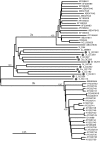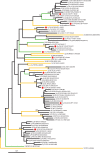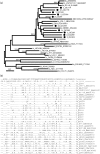Full-length sequences of 11 hepatitis C virus genotype 2 isolates representing five subtypes and six unclassified lineages with unique geographical distributions and genetic variation patterns
- PMID: 22357752
- PMCID: PMC3755518
- DOI: 10.1099/vir.0.038315-0
Full-length sequences of 11 hepatitis C virus genotype 2 isolates representing five subtypes and six unclassified lineages with unique geographical distributions and genetic variation patterns
Abstract
In this study, we characterized full-length hepatitis C virus (HCV) genome sequences for 11 genotype 2 isolates. They were isolated from the sera of 11 patients residing in Canada, of whom four had an African origin. Full-length genomes, each with 18-25 overlapping fragments, were obtained by PCR amplification. Five isolates represent the first complete genomes of subtypes 2d, 2e, 2j, 2m and 2r, while the other six correspond to variants that do not group within any assigned subtypes. These sequences had lengths of 9508-9825 nt and each contained a single ORF encoding 3012-3106 aa. Predicted amino acids were carefully inspected and unique variation patterns were recognized, especially for a 2e isolate, QC64. Phylogenetic analysis of complete genome sequences provides evidence that there are a total of 16 subtypes, of which 11 have been described here. Co-analysis with 68 partial NS5B sequences also differentiated 18 assigned subtypes, 2a-2r, and eight additional lineages within genotype 2, which is consistent with the analysis of complete genome sequences. The data from this study will now allow 10 assigned subtypes and six additional lineages of HCV genotype 2 to have their full-length genomes defined. Further analysis with 2021 genotype 2 sequences available in the HCV database indicated that the geographical distribution of these subtypes is consistent with an African origin, with particular subtypes having spread to Asia and the Americas.
Figures




Similar articles
-
Characterization of full-length hepatitis C virus sequences for subtypes 1e, 1h and 1l, and a novel variant revealed Cameroon as an area in origin for genotype 1.J Gen Virol. 2013 Aug;94(Pt 8):1780-1790. doi: 10.1099/vir.0.048835-0. Epub 2013 May 15. J Gen Virol. 2013. PMID: 23677792 Free PMC article.
-
Full-length genome sequences of five hepatitis C virus isolates representing subtypes 3g, 3h, 3i and 3k, and a unique genotype 3 variant.J Gen Virol. 2013 Mar;94(Pt 3):543-548. doi: 10.1099/vir.0.049668-0. Epub 2012 Nov 14. J Gen Virol. 2013. PMID: 23152370 Free PMC article.
-
Full-length genomes of 16 hepatitis C virus genotype 1 isolates representing subtypes 1c, 1d, 1e, 1g, 1h, 1i, 1j and 1k, and two new subtypes 1m and 1n, and four unclassified variants reveal ancestral relationships among subtypes.J Gen Virol. 2014 Jul;95(Pt 7):1479-1487. doi: 10.1099/vir.0.064980-0. Epub 2014 Apr 9. J Gen Virol. 2014. PMID: 24718832 Free PMC article.
-
Origin of hepatitis C virus genotype 3 in Africa as estimated through an evolutionary analysis of the full-length genomes of nine subtypes, including the newly sequenced 3d and 3e.J Gen Virol. 2014 Aug;95(Pt 8):1677-1688. doi: 10.1099/vir.0.065128-0. Epub 2014 May 2. J Gen Virol. 2014. PMID: 24795446 Free PMC article.
-
Entire genome sequences of two new HCV subtypes, 6r and 6s, and characterization of unique HVR1 variation patterns within genotype 6.J Viral Hepat. 2009 Jun;16(6):406-17. doi: 10.1111/j.1365-2893.2009.01086.x. Epub 2009 Mar 5. J Viral Hepat. 2009. PMID: 19281488
Cited by
-
Characterization of full-length hepatitis C virus sequences for subtypes 1e, 1h and 1l, and a novel variant revealed Cameroon as an area in origin for genotype 1.J Gen Virol. 2013 Aug;94(Pt 8):1780-1790. doi: 10.1099/vir.0.048835-0. Epub 2013 May 15. J Gen Virol. 2013. PMID: 23677792 Free PMC article.
-
Phylogenetic Analysis and Epidemic History of Hepatitis C Virus Genotype 2 in Tunisia, North Africa.PLoS One. 2016 Apr 21;11(4):e0153761. doi: 10.1371/journal.pone.0153761. eCollection 2016. PLoS One. 2016. PMID: 27100294 Free PMC article.
-
A panel of 16 full-length HCV genomes was characterized in China belonging to genotypes 1-6 including subtype 2f and two novel genotype 6 variants.Infect Genet Evol. 2013 Dec;20:225-9. doi: 10.1016/j.meegid.2013.08.014. Epub 2013 Sep 5. Infect Genet Evol. 2013. PMID: 24012950 Free PMC article.
-
Highly Diverse Hepatitis C Strains Detected in Sub-Saharan Africa Have Unknown Susceptibility to Direct-Acting Antiviral Treatments.Hepatology. 2019 Apr;69(4):1426-1441. doi: 10.1002/hep.30342. Epub 2019 Mar 22. Hepatology. 2019. PMID: 30387174 Free PMC article.
-
Subtyping genotype 2 hepatitis C viruses from Tunisia: identification of two putative new subtypes.Virus Genes. 2014 Apr;48(2):209-17. doi: 10.1007/s11262-013-1010-3. Epub 2013 Nov 23. Virus Genes. 2014. PMID: 24272697
References
-
- Abid K., Quadri R., Veuthey A. L., Hadengue A., Negro F. (2000). A novel hepatitis C virus (HCV) subtype from Somalia and its classification into HCV clade 3. J Gen Virol 81, 1485–1493 - PubMed
Publication types
MeSH terms
Substances
Associated data
- Actions
- Actions
- Actions
- Actions
- Actions
- Actions
- Actions
- Actions
- Actions
- Actions
- Actions
Grants and funding
LinkOut - more resources
Full Text Sources
Medical
Molecular Biology Databases
Research Materials

